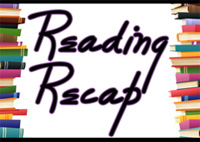 As the year winds down, many individuals look forward to breaks from school and work, and cherish extra time spent resting, reading, and frolicking with friends. Bibliophiles have additional reasons for getting excited about the end of the year since they know that the book awards announced by the American Library Association are just around the corner. Lists of the Best Books of the year in various categories begin to appear in newspapers and journals, and blogs start filling up with predictions about which book will receive the coveted awards for best picture book, best nonfiction title, and best book for young adults, among others. Announced on January 28 during the ALA Midwinter Conference, the winners of coveted awards such as the Caldecott, the Newbery, the Coretta Scott King Award, and the Sibert often receive a boost in book sales and garner additional attention as the result of the spotlight that shines on them at that time. For this week’s book reviews, members of the International Reading Association's Children’s Literature and Reading Special Interest Group took a second look at some of the fantastic picture book titles we’ve read during 2012, some of which we reviewed earlier in the year. But since they still resonate with us, we predict they’ll be included on many Best Books of 2012 lists. Next week we will highlight our favorite longer texts.
As the year winds down, many individuals look forward to breaks from school and work, and cherish extra time spent resting, reading, and frolicking with friends. Bibliophiles have additional reasons for getting excited about the end of the year since they know that the book awards announced by the American Library Association are just around the corner. Lists of the Best Books of the year in various categories begin to appear in newspapers and journals, and blogs start filling up with predictions about which book will receive the coveted awards for best picture book, best nonfiction title, and best book for young adults, among others. Announced on January 28 during the ALA Midwinter Conference, the winners of coveted awards such as the Caldecott, the Newbery, the Coretta Scott King Award, and the Sibert often receive a boost in book sales and garner additional attention as the result of the spotlight that shines on them at that time. For this week’s book reviews, members of the International Reading Association's Children’s Literature and Reading Special Interest Group took a second look at some of the fantastic picture book titles we’ve read during 2012, some of which we reviewed earlier in the year. But since they still resonate with us, we predict they’ll be included on many Best Books of 2012 lists. Next week we will highlight our favorite longer texts.
Buitrago, Jairo. (2012). Jimmy the greatest! Illus. by Rafael Yockteng; Translated by Elisa Amado. Toronto: Groundwood Books/ House of Anansi Press.
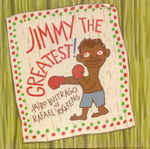 This Colombian author and illustrator team have crafted an inspirational story for young readers about a boy named Jimmy who aspires to become a boxer. He lives in a small Caribbean village by the sea where among the many ramshackle houses there is one small gym. Once Jimmy starts to hang out there, its owner, Don Apolinar, gives Jimmy a box of books and newspaper clippings about Muhammad Ali, also known as “the greatest” boxer ever. Jimmy reads all about the famous American boxer and starts to run, shadow box, and train to become a contender, although someone has stolen his shoes. While training, Jimmy realizes that many people, including the gym’s owner, wish to leave the small village to find a better life. Jimmy realizes that he wants stay in the village and manage the gym. He even adds a library. While young sports fans will enjoy this book, it is also a story of taking pride in what are doing and the job you have chosen and finding pleasure in your own local surroundings. The 2010 Spanish edition, Jimmy el más grande, has been nominated for Best Books of the Year by Venezuela's Banco del Libro.
This Colombian author and illustrator team have crafted an inspirational story for young readers about a boy named Jimmy who aspires to become a boxer. He lives in a small Caribbean village by the sea where among the many ramshackle houses there is one small gym. Once Jimmy starts to hang out there, its owner, Don Apolinar, gives Jimmy a box of books and newspaper clippings about Muhammad Ali, also known as “the greatest” boxer ever. Jimmy reads all about the famous American boxer and starts to run, shadow box, and train to become a contender, although someone has stolen his shoes. While training, Jimmy realizes that many people, including the gym’s owner, wish to leave the small village to find a better life. Jimmy realizes that he wants stay in the village and manage the gym. He even adds a library. While young sports fans will enjoy this book, it is also a story of taking pride in what are doing and the job you have chosen and finding pleasure in your own local surroundings. The 2010 Spanish edition, Jimmy el más grande, has been nominated for Best Books of the Year by Venezuela's Banco del Libro.
- Karen Hildebrand, Ohio Library and Reading Consultant
Buzzeo, Toni. (2012). One cool friend. Illus. by David Small. New York: Dial Books for Young Readers.
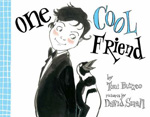 Elliot’s somewhat eccentric, green plaid suit-wearing father invites him to Family Fun Day at the aquarium. Prim and proper Elliot is less than enthusiastic about going but agrees to accompany his father, even politely saying, “Thank you for inviting me.” In trying to escape the crowds, Elliot discovers the penguins and is immediately impressed with their black tuxedo look and their proper postures. Totally taken in by the penguins, Elliot asks his father if he can have one to take home. Oblivious to what Elliot is really asking, Father agrees. Elliot hides the newly acquired penguin he names Magellan in his backpack. Once they get home, the fun begins as Elliot turns their mansion into a palatial penguin paradise, including lying around on bags of ice, flipping goldfish crackers into his mouth, and skating on the ice rink Elliot makes in one of the bedrooms with the air conditioner and a water hose. Readers will take note of the illustrator’s use of white and blue to create an Arctic-like color palette for background. Readers will be glued (“frozen?”) to the illustrations, creative layout and typography as the penguin’s antics unfold while living in a real house. Visit the author's website for a reader’s theater script and curriculum and activity kit. A sly little way to incorporate some library research awaits curious readers. Read more about the author in "5 Questions With... Toni Buzzeo" on the Engage blog.
Elliot’s somewhat eccentric, green plaid suit-wearing father invites him to Family Fun Day at the aquarium. Prim and proper Elliot is less than enthusiastic about going but agrees to accompany his father, even politely saying, “Thank you for inviting me.” In trying to escape the crowds, Elliot discovers the penguins and is immediately impressed with their black tuxedo look and their proper postures. Totally taken in by the penguins, Elliot asks his father if he can have one to take home. Oblivious to what Elliot is really asking, Father agrees. Elliot hides the newly acquired penguin he names Magellan in his backpack. Once they get home, the fun begins as Elliot turns their mansion into a palatial penguin paradise, including lying around on bags of ice, flipping goldfish crackers into his mouth, and skating on the ice rink Elliot makes in one of the bedrooms with the air conditioner and a water hose. Readers will take note of the illustrator’s use of white and blue to create an Arctic-like color palette for background. Readers will be glued (“frozen?”) to the illustrations, creative layout and typography as the penguin’s antics unfold while living in a real house. Visit the author's website for a reader’s theater script and curriculum and activity kit. A sly little way to incorporate some library research awaits curious readers. Read more about the author in "5 Questions With... Toni Buzzeo" on the Engage blog.
- Karen Hildebrand, Ohio Library and Reading Consultant
Cleminson, Katie. (2012). Otto the book bear. New York: Hyperion.
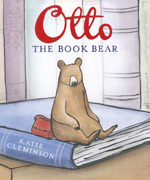 Tiny Otto is a brown bear that is perfectly content living in a book. He is particularly happy when someone reads his book, and he has a secret. He can come to life and explore his surroundings when no one is looking. Sadly, he is left behind when his family moves, and he must find a new home. Not surprisingly, he finds a welcoming place at the local library after wandering through the city streets. Not only does he find another book bear there, but plenty of other new friends. The gently told story and delightful illustrations that show the diminutive bear making his way among the very large objects that surround him. Young readers will relate to imagining what might happen if the animals in their favorite books could actually come to life and lead a busy existence of their own. They are also likely to sense the poignancy of books and characters left behind when their readers grow up and are no longer interested in them.
Tiny Otto is a brown bear that is perfectly content living in a book. He is particularly happy when someone reads his book, and he has a secret. He can come to life and explore his surroundings when no one is looking. Sadly, he is left behind when his family moves, and he must find a new home. Not surprisingly, he finds a welcoming place at the local library after wandering through the city streets. Not only does he find another book bear there, but plenty of other new friends. The gently told story and delightful illustrations that show the diminutive bear making his way among the very large objects that surround him. Young readers will relate to imagining what might happen if the animals in their favorite books could actually come to life and lead a busy existence of their own. They are also likely to sense the poignancy of books and characters left behind when their readers grow up and are no longer interested in them.
- Barbara A. Ward, Washington State University Pullman
Dormer, Frank W. (2012). The obstinate pen. New York: Henry Holt.
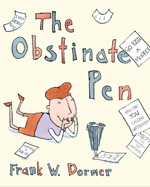 This clever picture book will make a fun read aloud and writing mentor text in elementary classrooms. Uncle Flood, nephew to Horace, is a writer who purchases a brand new pen. He sits down to write and composes: “The following story is all true” (unpaged), but his new pen does not write this sentence he had in mind. Instead, it writes, “You have a BIG nose” (unpaged). Everything Uncle Flood tries to write, the pen ignores and writes something different. In anger, Uncle Flood throws the pen out the window, and a police officer finds it. Later, Officer Wonkle tries to write a woman named Miss Weeble a ticket, but the pen writes, “Kiss that girl!” (unpaged). The officer tries to write the ticket again but decides to take the pen’s advice and kiss Miss Weeble’s cheek. The pen continues to travel from person to person and eventually ends up in Horace’s hands. Horace admires his new pen and uses it in a unique and different way. Children could be invited to think of a different inanimate object such as a car, eraser, chair or book that could come to life and write and illustrate their own picture book after reading this one.
This clever picture book will make a fun read aloud and writing mentor text in elementary classrooms. Uncle Flood, nephew to Horace, is a writer who purchases a brand new pen. He sits down to write and composes: “The following story is all true” (unpaged), but his new pen does not write this sentence he had in mind. Instead, it writes, “You have a BIG nose” (unpaged). Everything Uncle Flood tries to write, the pen ignores and writes something different. In anger, Uncle Flood throws the pen out the window, and a police officer finds it. Later, Officer Wonkle tries to write a woman named Miss Weeble a ticket, but the pen writes, “Kiss that girl!” (unpaged). The officer tries to write the ticket again but decides to take the pen’s advice and kiss Miss Weeble’s cheek. The pen continues to travel from person to person and eventually ends up in Horace’s hands. Horace admires his new pen and uses it in a unique and different way. Children could be invited to think of a different inanimate object such as a car, eraser, chair or book that could come to life and write and illustrate their own picture book after reading this one.
- Deanna Day, Washington State University Vancouver
Dyckman, Ame. (2012). Boy + Bot. Illus. by Dan Yaccarino. New York: Alfred A. Knopf.
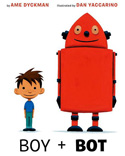 Ame Dyckman’s debut into the picture book world begins with this BFR (Big Friendly Robot). One day Boy meets Robot in the woods, and they become instant friends. When Robot goes home to play with Boy, his on/off button gets pushed, and he powers down. Boy thinks there is something wrong and uses traditional home remedies to nurse his new friend back to life: applesauce and reading aloud. When Boy falls asleep, Bot’s button is pushed back to ON, and now he thinks something is wrong with Boy. With only technological know-how, he tries to bring Boy to life using oil and reading the instruction manual. When Bot tries to think how a battery might help, Inventor arrives to yell, “Stop!” and is able to remedy the situation. Told in simple language, this story describes the very real friendship that has developed between Boy and Bot depicted warmly in the wordless double-page spreads at the end of the book. Readers may want to visit the author’s website and blog.
Ame Dyckman’s debut into the picture book world begins with this BFR (Big Friendly Robot). One day Boy meets Robot in the woods, and they become instant friends. When Robot goes home to play with Boy, his on/off button gets pushed, and he powers down. Boy thinks there is something wrong and uses traditional home remedies to nurse his new friend back to life: applesauce and reading aloud. When Boy falls asleep, Bot’s button is pushed back to ON, and now he thinks something is wrong with Boy. With only technological know-how, he tries to bring Boy to life using oil and reading the instruction manual. When Bot tries to think how a battery might help, Inventor arrives to yell, “Stop!” and is able to remedy the situation. Told in simple language, this story describes the very real friendship that has developed between Boy and Bot depicted warmly in the wordless double-page spreads at the end of the book. Readers may want to visit the author’s website and blog.
- Karen Hildebrand, Ohio Library and Reading Consultant
Eversole, Robyn. (2012). East dragon, west dragon. Illus. by Scott Campbell. New York: Atheneum Books for Young Readers.
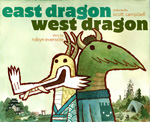 Through humorous and anachronistic illustrations, Dragon East and Dragon West are introduced. Dragon West lives in his boy cave with video games and an assortment of balls and is often bothered by pesky knights seeking adventure. Meanwhile, Dragon East lives a rather refined life spent learning to paint and write. After Dragon West sends those bothersome knights on a fool’s errand toward the lands of Dragon East, the two dragons eventually meet in an effort to get rid of the pesky knights. However, they must face each other, and they are somewhat fearful of what the other dragon’s powers might entail. As the two overcome these initial fears, they learn to become friends. Although each dragon comes from vastly different backgrounds and cultures, their friendship becomes real as well as respectful. Teachers can extend this book with the lesson from Learning to Give.
Through humorous and anachronistic illustrations, Dragon East and Dragon West are introduced. Dragon West lives in his boy cave with video games and an assortment of balls and is often bothered by pesky knights seeking adventure. Meanwhile, Dragon East lives a rather refined life spent learning to paint and write. After Dragon West sends those bothersome knights on a fool’s errand toward the lands of Dragon East, the two dragons eventually meet in an effort to get rid of the pesky knights. However, they must face each other, and they are somewhat fearful of what the other dragon’s powers might entail. As the two overcome these initial fears, they learn to become friends. Although each dragon comes from vastly different backgrounds and cultures, their friendship becomes real as well as respectful. Teachers can extend this book with the lesson from Learning to Give.
- Karen Hildebrand, Ohio Library and Reading Consultant
Fleming, Candace. (2012). Oh, No! Illus. by Eric Rohmann. New York: Random House/Schwartz & Wade.
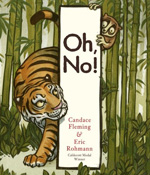 One by one, several animals tumble into a hole so deep that they cannot get out without help. A frog, a mouse, a loris, a sun bear, and a monkey all try and fail to get out of that hole. In the end, an elephant saves the day, using its size to rescue the hapless creatures before they can be eaten by a hungry tiger that has been lurking nearby. Young readers will love the wonderful animal sounds used throughout the book. For instance, anyone reading the title aloud will enjoy the “slop-slurp! slop-slurp!” (unpaged) of the tiger licking his teeth. The repetitive "Oh, no!" phrase that appears as each animal gets trapped will elicit audience response as readers realize that something unfortunate is happening. Readers will laugh at how the tiger gets his just desserts in the end and how the "Oh, no!" ends up being turned on him. The relief prints lend a folkloric flavor to the text. Young readers will clamor for multiple readings of this title and delight in the well-told story and the expressions on the faces of those animals.
One by one, several animals tumble into a hole so deep that they cannot get out without help. A frog, a mouse, a loris, a sun bear, and a monkey all try and fail to get out of that hole. In the end, an elephant saves the day, using its size to rescue the hapless creatures before they can be eaten by a hungry tiger that has been lurking nearby. Young readers will love the wonderful animal sounds used throughout the book. For instance, anyone reading the title aloud will enjoy the “slop-slurp! slop-slurp!” (unpaged) of the tiger licking his teeth. The repetitive "Oh, no!" phrase that appears as each animal gets trapped will elicit audience response as readers realize that something unfortunate is happening. Readers will laugh at how the tiger gets his just desserts in the end and how the "Oh, no!" ends up being turned on him. The relief prints lend a folkloric flavor to the text. Young readers will clamor for multiple readings of this title and delight in the well-told story and the expressions on the faces of those animals.
- Barbara A. Ward, Washington State University Pullman
Fogliano, Julie. (2012). And then it’s spring. Illus. by Erin Stead. New York: Macmillan/Roaring Brook Press.
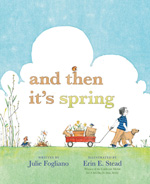 With winter’s chill blanketing the country with icy gifts, even the most stalwart among us long for spring’s greenery and warmer temperatures. Dressed in winter wear, including a red knitted hat and scarf to keep him warm, a boy anticipates the coming of spring. Despite the bleak brown landscape that surrounds him, he plants seeds in hopes of warmer weather. His dog, a turtle, a bunny, and various birds keep watch. Hoping for rain and some sunshine, he worries when no plants appear. Eventually, when he peers out the door of his house, everything is green. Each page of this book is filled with some delight that observant readers will catch; for instance, the smoke rising from the red house on the hill diminishes over the pages as the days pass, and temperatures begin to rise. In a wonderful cutaway view of the earth readers are able to see all the creatures busily tunneling through the soil as he puts his head against the ground. Created with pencil and through woodblock printing techniques, the illustrations capture the different shades of brown and the soft shades of green in a newly awakened world. This memorable picture book contains subtle secrets that are revealed upon multiple readings.
With winter’s chill blanketing the country with icy gifts, even the most stalwart among us long for spring’s greenery and warmer temperatures. Dressed in winter wear, including a red knitted hat and scarf to keep him warm, a boy anticipates the coming of spring. Despite the bleak brown landscape that surrounds him, he plants seeds in hopes of warmer weather. His dog, a turtle, a bunny, and various birds keep watch. Hoping for rain and some sunshine, he worries when no plants appear. Eventually, when he peers out the door of his house, everything is green. Each page of this book is filled with some delight that observant readers will catch; for instance, the smoke rising from the red house on the hill diminishes over the pages as the days pass, and temperatures begin to rise. In a wonderful cutaway view of the earth readers are able to see all the creatures busily tunneling through the soil as he puts his head against the ground. Created with pencil and through woodblock printing techniques, the illustrations capture the different shades of brown and the soft shades of green in a newly awakened world. This memorable picture book contains subtle secrets that are revealed upon multiple readings.
- Barbara A. Ward, Washington State University Pullman
Gravett, Emily. (2012). Wolf won’t bite. New York: Macmillan.
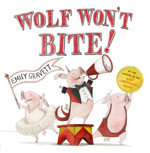 As is typical of any picture book created by this author/illustrator, this latest one not only contains elements of wit and whimsy, but it prompts reflection. In this cautionary tale about making assumptions about what others will or won't do, three pigs capture a gray wolf. They put the poor creature through his paces, forcing him to stand on a stool, dressing him in a bow, and finding all sorts of fun activities involving the wolf (fun for them, that is, but certainly not for him). What the three pigs make Wolf do gets worse and worse as the story goes on. For instance, they even fling knives at a target where he's standing and saw him in half, all the while bragging that he won't bite. Just as they get ready to put their heads in his mouth, his eyes show exactly what he's thinking--and have they got a surprise in store for them! A perfect read aloud, this picture book effectively builds suspense in readers and will prompt guffaws at its conclusion. It’s clear that Wolf—and anyone else—will bite after he’s had enough.
As is typical of any picture book created by this author/illustrator, this latest one not only contains elements of wit and whimsy, but it prompts reflection. In this cautionary tale about making assumptions about what others will or won't do, three pigs capture a gray wolf. They put the poor creature through his paces, forcing him to stand on a stool, dressing him in a bow, and finding all sorts of fun activities involving the wolf (fun for them, that is, but certainly not for him). What the three pigs make Wolf do gets worse and worse as the story goes on. For instance, they even fling knives at a target where he's standing and saw him in half, all the while bragging that he won't bite. Just as they get ready to put their heads in his mouth, his eyes show exactly what he's thinking--and have they got a surprise in store for them! A perfect read aloud, this picture book effectively builds suspense in readers and will prompt guffaws at its conclusion. It’s clear that Wolf—and anyone else—will bite after he’s had enough.
- Barbara A. Ward, Washington State University Pullman
Hills, Tad. (2012). Rocket writes a story. New York: Schwartz & Wade Books/ Random House.
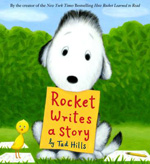
Created by the author and illustrator of How Rocket Learned to Read (Schwartz & Wade, 2010), this picture book is a perfect mentor text during writing workshop. The book begins with Rocket sniffing out some new words and writing them down on sticky notes—buttercup, bug, feather, and nest. With the help of a little yellow bird, his teacher, he reads all of his splendid words and announces, “I’m going to write a story!” (unpaged). But Rocket experiences something many writers go through: He stares at the blank pages, but no story comes. His teacher suggests he think about characters and something that has happened to him as a possible starting point. In addition, walking, sniffing, drawing, and visiting his favorite tree help Rocket slowly begin to craft a story. Rocket’s persistence, revision and help from friends make a difference too. Finally, he completes his tale and celebrates by reading it aloud to a new pal. Each step of Rocket’s writing process is exactly what all writers experience as they learn to write. Readers will want to visit the author’s website to watch and meet the real Rocket.
- Deanna Day, Washington State University Vancouver
Jenkins, Steve. (2012). The beetle book. Boston: Houghton Mifflin Books for Children.
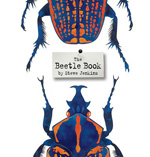 Summer brings out the bug collectors in kids as they reach for butterfly nets and jars with holes in the lids. Steve Jenkins has proven himself many times over as a master of book design through his detailed cut-paper illustrations in other great nonfiction titles such as Actual Size (2004), Move! (2006), Living Color (2007), Life on Earth (2002), and many more. His latest work delves into the vast world of beetles, beginning with the incredible fact that every fourth living thing is a beetle. Scientists have named over 350,000 beetles to date and believe there are even more yet to be identified. Jenkins has presented dozens of beetles and accompanying information. His black silhouette illustrations often show the actual size of the beetles. Facts about numerous species, habitats, physiology and unusual characteristics coupled with beautifully detailed illustrations make this a bug-lovers delight. Readers may enjoy writing some buggy poetry from a lesson found at ReadWriteThink. They can learn more about this author on the 7 Impossible Things before Breakfast blog or visit the author/illustrator’s website.
Summer brings out the bug collectors in kids as they reach for butterfly nets and jars with holes in the lids. Steve Jenkins has proven himself many times over as a master of book design through his detailed cut-paper illustrations in other great nonfiction titles such as Actual Size (2004), Move! (2006), Living Color (2007), Life on Earth (2002), and many more. His latest work delves into the vast world of beetles, beginning with the incredible fact that every fourth living thing is a beetle. Scientists have named over 350,000 beetles to date and believe there are even more yet to be identified. Jenkins has presented dozens of beetles and accompanying information. His black silhouette illustrations often show the actual size of the beetles. Facts about numerous species, habitats, physiology and unusual characteristics coupled with beautifully detailed illustrations make this a bug-lovers delight. Readers may enjoy writing some buggy poetry from a lesson found at ReadWriteThink. They can learn more about this author on the 7 Impossible Things before Breakfast blog or visit the author/illustrator’s website.
- Karen Hildebrand, Ohio Library and Reading Consultant
Joyce, William. (2012). The fantastic flying books of Morris Lessmore. Illus. by William Joyce & Joe Bluhm. New York: Simon & Schuster/Atheneum.
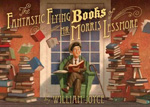 A bibliophile's delight, this marvelous picture book pays tribute to the wonder of reading, writing, and books. After a storm scatters the words in the bookish Morris Lessmore's manuscript, he heads off on a journey to find them. Eventually, he ends up in a place "where many books apparently 'nested'" (unpaged) and becomes their caretaker. The description of how the books refused to stay organized and mixed themselves up is delightful as well as the comment that even while Morris aged, the books never changed as time passed. The multimedia illustrations are stunning, and just as delightful as the story being told in this book. Anyone who loves reading or simply delights in filling shelf after shelf with well-thumbed books will cherish this imaginative title. Every line of text and illustration exude a bibliophile’s single-minded passion, and as in the case with all great books, there's something new to enjoy upon subsequent reads. There could be no more appropriate tribute to those tireless promoters of books, Bill Morris and Coleen Salley.
A bibliophile's delight, this marvelous picture book pays tribute to the wonder of reading, writing, and books. After a storm scatters the words in the bookish Morris Lessmore's manuscript, he heads off on a journey to find them. Eventually, he ends up in a place "where many books apparently 'nested'" (unpaged) and becomes their caretaker. The description of how the books refused to stay organized and mixed themselves up is delightful as well as the comment that even while Morris aged, the books never changed as time passed. The multimedia illustrations are stunning, and just as delightful as the story being told in this book. Anyone who loves reading or simply delights in filling shelf after shelf with well-thumbed books will cherish this imaginative title. Every line of text and illustration exude a bibliophile’s single-minded passion, and as in the case with all great books, there's something new to enjoy upon subsequent reads. There could be no more appropriate tribute to those tireless promoters of books, Bill Morris and Coleen Salley.
- Barbara A. Ward, Washington State University Pullman
Katz, Jon. (2012). Lenore finds a friend: A true story from Bedlam farm. New York: Henry Holt.
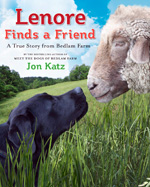 Finding friends with whom to play or eat lunch isn’t always easy. Just like humans, dogs sometimes have those same problems. In bright photographs readers meet Lenore, a black Labrador retriever, who perseveres and finally makes a friend. As a puppy Lenore tried to make friends with a rooster and donkey, but they crowed or kicked her. Even another dog, Rose, was too busy herding sheep to be friends with Lenore. One day, Lenore meets a grumpy ram named Brutus and gives him a big kiss on his nose. Brutus has never been kissed before and doesn’t know what to do. The next day Lenore returns and kisses Brutus on the nose again. Rose tries to interfere by barking and growling at this odd animal pairing, but Lenore doesn’t give up. The next morning she returns to the pasture and finds Brutus. They touch noses, eat grass and hang out together. Lenore has finally found a friend. Teachers could make a T-chart and invite students to list all of the different things Lenore did to make friends. On the other side of the chart students could discuss what they could do to make friends.
Finding friends with whom to play or eat lunch isn’t always easy. Just like humans, dogs sometimes have those same problems. In bright photographs readers meet Lenore, a black Labrador retriever, who perseveres and finally makes a friend. As a puppy Lenore tried to make friends with a rooster and donkey, but they crowed or kicked her. Even another dog, Rose, was too busy herding sheep to be friends with Lenore. One day, Lenore meets a grumpy ram named Brutus and gives him a big kiss on his nose. Brutus has never been kissed before and doesn’t know what to do. The next day Lenore returns and kisses Brutus on the nose again. Rose tries to interfere by barking and growling at this odd animal pairing, but Lenore doesn’t give up. The next morning she returns to the pasture and finds Brutus. They touch noses, eat grass and hang out together. Lenore has finally found a friend. Teachers could make a T-chart and invite students to list all of the different things Lenore did to make friends. On the other side of the chart students could discuss what they could do to make friends.
- Deanna Day, Washington State University Vancouver
King, Martin Luther King, Jr. (2012). I have a dream. Illus. by Kadir Nelson. New York: Schwartz & Wade Books/Random House.
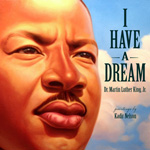 On August 28, 1968, on the day of the March on Washington, D.C., Martin Luther King, Jr., delivered his famous “I Have a Dream” speech on the steps of the Lincoln Memorial. The publishers have included a CD of the actual speech in this beautifully illustrated version of the famous speech. Taken page by page, Nelson’s oil paintings make Dr. King’s ideas come alive for young readers today. Each page and double-page spread represent the concepts that Dr. King was so emphatically purporting at the time, representing peace and justice and freedom in a world where blacks and whites would live together in harmony. Readers will want to watch Kadir Nelson discuss this new book from his speech at Book Expo America or watch Martin Luther King give the original speech at You Tube. Teachers might like to try the interactive “Word Mover for ‘I Have a Dream’” from ReadWriteThink.
On August 28, 1968, on the day of the March on Washington, D.C., Martin Luther King, Jr., delivered his famous “I Have a Dream” speech on the steps of the Lincoln Memorial. The publishers have included a CD of the actual speech in this beautifully illustrated version of the famous speech. Taken page by page, Nelson’s oil paintings make Dr. King’s ideas come alive for young readers today. Each page and double-page spread represent the concepts that Dr. King was so emphatically purporting at the time, representing peace and justice and freedom in a world where blacks and whites would live together in harmony. Readers will want to watch Kadir Nelson discuss this new book from his speech at Book Expo America or watch Martin Luther King give the original speech at You Tube. Teachers might like to try the interactive “Word Mover for ‘I Have a Dream’” from ReadWriteThink.
- Karen Hildebrand, Ohio Library and Reading Consultant
Klise, Kate. (2012). Grammy Lamby and the secret handshake. Illus. by M. Sarah Klise. New York: Henry Holt.
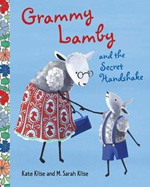 After hearing or reading this fun picture book, children will automatically use “the secret handshake” when they hold a family member’s hand. Larry, who was a little lamb, didn’t care for his Grammy. When Grammy visited she talked too much, sang too loudly during church and dreamed of taking Larry to exotic places he didn’t want to visit. Grammy taught him a secret handshake, yet he imagined it meant, “Please (squeeze). Go (squeeze). Away (squeeze)” (unpaged). But Grammy’s boisterous attitude proves to be helpful when a summer storm tears a hole in the family’s roof. She immediately begins patching and repairing the home while telling wonderful stories to Larry. Then Grammy helps rebuild the community school and church. Her sewing machine also comes in handy as she makes clothes and curtains for anyone who needs them. Larry begins to see his grandmother in a different light, and when it is time for her to return home he has a special present that accompanies the secret handshake. For more information about the author read her Engage blog post "Beyond the Notebook: Start with a Transcript."
After hearing or reading this fun picture book, children will automatically use “the secret handshake” when they hold a family member’s hand. Larry, who was a little lamb, didn’t care for his Grammy. When Grammy visited she talked too much, sang too loudly during church and dreamed of taking Larry to exotic places he didn’t want to visit. Grammy taught him a secret handshake, yet he imagined it meant, “Please (squeeze). Go (squeeze). Away (squeeze)” (unpaged). But Grammy’s boisterous attitude proves to be helpful when a summer storm tears a hole in the family’s roof. She immediately begins patching and repairing the home while telling wonderful stories to Larry. Then Grammy helps rebuild the community school and church. Her sewing machine also comes in handy as she makes clothes and curtains for anyone who needs them. Larry begins to see his grandmother in a different light, and when it is time for her to return home he has a special present that accompanies the secret handshake. For more information about the author read her Engage blog post "Beyond the Notebook: Start with a Transcript."
- Deanna Day, Washington State University Vancouver
Kooser, Ted. (2012). House held up by trees. Illus. by Jon Klassen. Somerville, MA: Candlewick.
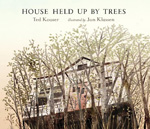 A house stands alone on a lot from which all the trees have been cleared. There are trees on both sides of the lot where the two children who live in the house love to play, but no trees near their home. Although seedlings from the trees land on the house's lawn, the father vigilantly removes them. The author never explains why he has this obsession to maintain a pristine, treeless lawn, but he spends a great deal of time doing so. Time passes, the children grow up and move away, and the father decides to sell the house. Strangely, no one is interested in buying it, and eventually seeds sprout and grow, surrounding the house and lifting it from its foundation. Although every word in this story is memorable, one phrase in particular describes the gentleness of the trees as they support the house "as if it was a bird's nest in the fingers of their branches" (unpaged). Long after the original homeowner has given up his battle against the trees, they have forgiven him and keep the forgotten house intact, supported in its branches. The gouache illustrations on every page are memorable, in some places showing the greenery that creeps steadily along the house's walls. The way the illustrations and text mark the inevitable passage of time and honor nature's ability to heal the wounds caused by humanity stays with readers even after the book is on the bookshelf.
A house stands alone on a lot from which all the trees have been cleared. There are trees on both sides of the lot where the two children who live in the house love to play, but no trees near their home. Although seedlings from the trees land on the house's lawn, the father vigilantly removes them. The author never explains why he has this obsession to maintain a pristine, treeless lawn, but he spends a great deal of time doing so. Time passes, the children grow up and move away, and the father decides to sell the house. Strangely, no one is interested in buying it, and eventually seeds sprout and grow, surrounding the house and lifting it from its foundation. Although every word in this story is memorable, one phrase in particular describes the gentleness of the trees as they support the house "as if it was a bird's nest in the fingers of their branches" (unpaged). Long after the original homeowner has given up his battle against the trees, they have forgiven him and keep the forgotten house intact, supported in its branches. The gouache illustrations on every page are memorable, in some places showing the greenery that creeps steadily along the house's walls. The way the illustrations and text mark the inevitable passage of time and honor nature's ability to heal the wounds caused by humanity stays with readers even after the book is on the bookshelf.
- Barbara A. Ward, Washington State University Pullman
Maclear, Kyo. (2012). Virginia Wolf. Illus. by Isabelle Arsenault. Toronto, ON: Kids Can Press.
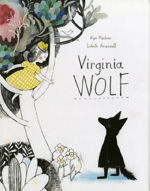 This picture book is based on the lives of famous writer Virginia Woolf and her older sister, painter Vanessa Bell. One day Virginia wakes up and feels wolfish, making wolf sounds and acting strangely. Through the accompanying mixed media illustrations of ink, pencil, watercolor and gouache, children will notice that Virginia is in bed with the covers pulled high, disguised like a wolf. In addition, her bedroom floor looks like a tornado has swept through the room. In order to change Virginia’s mood, Vanessa tries just about everything: painting a picture, wearing her favorite dress, offering treats and making faces, but Virginia exclaims, “LEAVE ME ALONE” (unpaged). After a while, Vanessa lies down beside her sister and asks where she would like to fly. Virginia then begins to paint a beautiful place where there are no doldrums. This perfect place has candy blossoms, purple butterflies, lollipop trees and fields to roam in. Virginia’s mood finally changes from down to up. In one of the final illustrations the wolf masquerade is clarified. All children have gloomy, grumpy or growly days and will be able to relate to this humorous and exquisitely illustrated book.
This picture book is based on the lives of famous writer Virginia Woolf and her older sister, painter Vanessa Bell. One day Virginia wakes up and feels wolfish, making wolf sounds and acting strangely. Through the accompanying mixed media illustrations of ink, pencil, watercolor and gouache, children will notice that Virginia is in bed with the covers pulled high, disguised like a wolf. In addition, her bedroom floor looks like a tornado has swept through the room. In order to change Virginia’s mood, Vanessa tries just about everything: painting a picture, wearing her favorite dress, offering treats and making faces, but Virginia exclaims, “LEAVE ME ALONE” (unpaged). After a while, Vanessa lies down beside her sister and asks where she would like to fly. Virginia then begins to paint a beautiful place where there are no doldrums. This perfect place has candy blossoms, purple butterflies, lollipop trees and fields to roam in. Virginia’s mood finally changes from down to up. In one of the final illustrations the wolf masquerade is clarified. All children have gloomy, grumpy or growly days and will be able to relate to this humorous and exquisitely illustrated book.
- Deanna Day, Washington State University Vancouver
Smith, Lane. (2012). Abe Lincoln’s dream. New York: Roaring Brook Press/Macmillan Publishers.
 Smith sets the tone for this book in the opening wordless panels with a frightened dog (Roosevelt’s Scottish terrier, Fala) roaming the White House. Readers quickly learn that other Presidential dogs who lived in the White House as well, feeling especially terrified of one particular bedroom. The storyline then changes to a school tour of the White House on President’s Day. However, one young girl, Quincy, has slipped away from the school group when she spies a very tall pale man in a stovepipe hat walking through a wall. At that moment, Quincy meets the ghost of Abraham Lincoln. Through simple humor and complex questions Quincy and Abe become friends, and she brings Mr. Lincoln up to date on what has been happening since 1865. Hand in hand, Quincy and President Lincoln fly over many national monuments until Abe is feeling better about the current state of affairs in the country. This beautifully told story uses subtle illustrations and varying sizes of typography to create an atmosphere of quiet reflection that Lincoln has fulfilled his dream of unity. Teachers might like to introduce the book with this very well done book trailer or visit the author’s website.
Smith sets the tone for this book in the opening wordless panels with a frightened dog (Roosevelt’s Scottish terrier, Fala) roaming the White House. Readers quickly learn that other Presidential dogs who lived in the White House as well, feeling especially terrified of one particular bedroom. The storyline then changes to a school tour of the White House on President’s Day. However, one young girl, Quincy, has slipped away from the school group when she spies a very tall pale man in a stovepipe hat walking through a wall. At that moment, Quincy meets the ghost of Abraham Lincoln. Through simple humor and complex questions Quincy and Abe become friends, and she brings Mr. Lincoln up to date on what has been happening since 1865. Hand in hand, Quincy and President Lincoln fly over many national monuments until Abe is feeling better about the current state of affairs in the country. This beautifully told story uses subtle illustrations and varying sizes of typography to create an atmosphere of quiet reflection that Lincoln has fulfilled his dream of unity. Teachers might like to introduce the book with this very well done book trailer or visit the author’s website.
- Karen Hildebrand, Ohio Library and Reading Consultant
Woodson, Jacqueline. (2012). Each kindness. Illus. by E. B. Lewis. New York: Nancy Paulsen Books/Penguin Publishers.
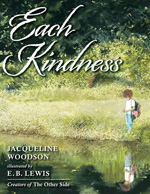 Chloe and her friends do not want to play with the new girl, Maya. Maya is wearing old and worn hand-me-down clothes and brings old toys to school. When Maya asks the girls to play with her on the playground, they ignore her. As the school days go by and Chloe and her friends refuse to include Maya, Maya continues to play by herself. One day, her classroom seat is empty, and Chloe wonders where Maya might be. Eventually the teacher announces that Maya and her family have moved away. The teacher goes on to share a lesson about the ripple effect of your actions. Chloe feels guilty for the way she treated Maya and realizes that there is no way to take back her cruel actions. This author-illustrator team has created another emotionally appealing book similar to their earlier title The Other Side (2001), providing readers with two books with similar themes to compare and contrast. The cover of the book is especially discussion-worthy. Readers may enjoy an interview with the author on The Brown Bookshelf blog.
Chloe and her friends do not want to play with the new girl, Maya. Maya is wearing old and worn hand-me-down clothes and brings old toys to school. When Maya asks the girls to play with her on the playground, they ignore her. As the school days go by and Chloe and her friends refuse to include Maya, Maya continues to play by herself. One day, her classroom seat is empty, and Chloe wonders where Maya might be. Eventually the teacher announces that Maya and her family have moved away. The teacher goes on to share a lesson about the ripple effect of your actions. Chloe feels guilty for the way she treated Maya and realizes that there is no way to take back her cruel actions. This author-illustrator team has created another emotionally appealing book similar to their earlier title The Other Side (2001), providing readers with two books with similar themes to compare and contrast. The cover of the book is especially discussion-worthy. Readers may enjoy an interview with the author on The Brown Bookshelf blog.
- Karen Hildebrand, Ohio Library and Reading Consultant
Zalben, Jane Breskin. (2012). Mousterpiece. New York: Roaring Brook Press/Macmillan.
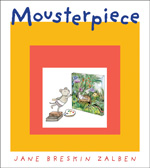 Janson the mouse lives in a corner of the art museum, and each night she explores the area around her. One night she comes upon a part of the museum she has never seen before that contains the modern art wing. She is amazed at the art work and a whole new world opens up for her. When the wing is closed for renovation, she is cut off from her new discoveries. However, this spurs her to create her own art. Soon paintings from Janson appear that look unsurprisingly familiar – spinoffs from the masters she observed in the modern art wing. When the director of the museum finds her artwork, he arranges for an exhibit of her work, especially those pieces that are actually her own original style. The end of the book features thumbnail pictures and information of all the artists that Janson enjoyed during her tour of the modern art wing. Readers can check out the activities the author has prepared on her website. Teachers might enjoy the article by T. Lee Williams from The Reading Teacher (2007) entitled “Reading the Painting” at Exploring Visual Literacy in the Primary Grades.”
Janson the mouse lives in a corner of the art museum, and each night she explores the area around her. One night she comes upon a part of the museum she has never seen before that contains the modern art wing. She is amazed at the art work and a whole new world opens up for her. When the wing is closed for renovation, she is cut off from her new discoveries. However, this spurs her to create her own art. Soon paintings from Janson appear that look unsurprisingly familiar – spinoffs from the masters she observed in the modern art wing. When the director of the museum finds her artwork, he arranges for an exhibit of her work, especially those pieces that are actually her own original style. The end of the book features thumbnail pictures and information of all the artists that Janson enjoyed during her tour of the modern art wing. Readers can check out the activities the author has prepared on her website. Teachers might enjoy the article by T. Lee Williams from The Reading Teacher (2007) entitled “Reading the Painting” at Exploring Visual Literacy in the Primary Grades.”
- Karen Hildebrand, Ohio Library and Reading Consultant
These reviews are submitted by members of the International Reading Association's Children's Literature and Reading Special Interest Group (CL/R SIG) and are published weekly on Reading Today Online. The International Reading Association partners with the National Council of Teachers of English and Verizon Thinkfinity to produce ReadWriteThink.org, a website devoted to providing literacy instruction and interactive resources for grades K–12.